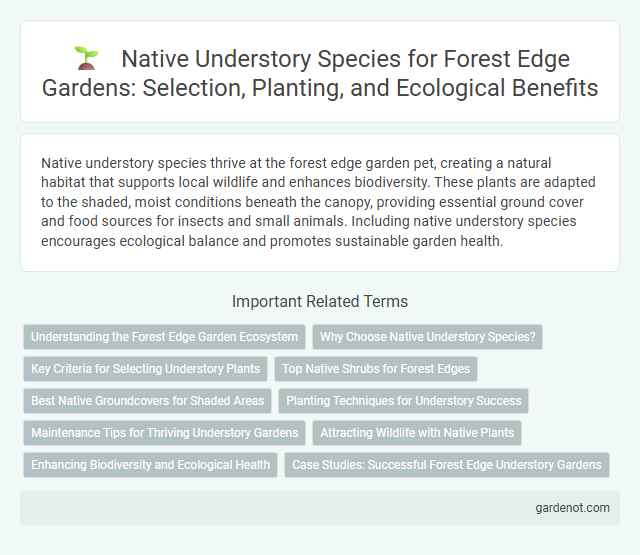Native understory species thrive at the forest edge garden pet, creating a natural habitat that supports local wildlife and enhances biodiversity. These plants are adapted to the shaded, moist conditions beneath the canopy, providing essential ground cover and food sources for insects and small animals. Including native understory species encourages ecological balance and promotes sustainable garden health.
Understanding the Forest Edge Garden Ecosystem
Native understory species in a forest edge garden play a critical role in maintaining biodiversity and ecosystem health by providing habitat and food sources for wildlife. These plants, such as trilliums, ferns, and wild ginger, thrive in shaded, moist conditions and help stabilize soil while enhancing nutrient cycling. Understanding their growth patterns and interactions supports sustainable garden management and promotes resilience against environmental stressors.
Why Choose Native Understory Species?
Native understory species in forest edge gardens enhance biodiversity by supporting local wildlife and maintaining ecosystem balance. These plants are adapted to regional soil, climate, and moisture conditions, ensuring resilience and reduced maintenance. Choosing native understory species promotes soil health, prevents erosion, and fosters natural habitat connectivity vital for pollinators and other beneficial organisms.
Key Criteria for Selecting Understory Plants
Native understory species in forest edge gardens provide essential habitat, improve soil health, and support local biodiversity. Key criteria for selecting these plants include shade tolerance, adaptability to soil moisture levels, and their role in supporting pollinators or wildlife. Prioritizing native species such as trilliums, wild ginger, and ferns ensures ecological balance and sustainable growth.
Top Native Shrubs for Forest Edges
Top native shrubs for forest edges include spicebush (Lindera benzoin), witch hazel (Hamamelis virginiana), and mountain laurel (Kalmia latifolia), all known for their adaptability and ecological benefits. These understory species provide essential habitat, food sources for wildlife, and contribute to soil stabilization in transitional zones. Their deep root systems and seasonal foliage enhance biodiversity and promote a resilient forest edge ecosystem.
Best Native Groundcovers for Shaded Areas
Best native groundcovers for shaded forest edge gardens include species like wild ginger (Asarum canadense), foamflower (Tiarella cordifolia), and Pennsylvania sedge (Carex pensylvanica), known for their shade tolerance and soil stabilization abilities. These native understory plants improve biodiversity by supporting local pollinators and wildlife while enhancing the garden's natural aesthetic. Selecting these groundcovers reduces maintenance needs and promotes healthy forest-edge ecosystems by mimicking natural plant communities.
Planting Techniques for Understory Success
Selecting native understory species such as trillium, foamflower, and wild ginger enhances biodiversity and promotes ecological balance in a forest edge garden. Effective planting techniques include preparing well-drained, humus-rich soil and positioning plants in dappled shade to mimic natural light conditions. Maintaining consistent moisture levels and avoiding soil compaction improve root development and long-term understory growth success.
Maintenance Tips for Thriving Understory Gardens
Native understory species in forest edge gardens require well-drained soil and partial shade to thrive, mimicking their natural woodland environment. Regular mulching with organic matter helps retain moisture and suppress weeds, promoting healthy root systems. Periodic pruning of dead or diseased foliage encourages vigorous growth and maintains the garden's ecological balance.
Attracting Wildlife with Native Plants
Native understory species in forest edge gardens such as Spicebush (Lindera benzoin), Wild Ginger (Asarum canadense), and Trillium (Trillium spp.) create essential habitat and food sources for pollinators, birds, and small mammals. These plants support local biodiversity by providing nectar, berries, and shelter while thriving in shaded, nutrient-rich environments characteristic of forest edges. Encouraging the growth of diverse native understory species enhances ecosystem stability and attracts a wide array of wildlife by mimicking natural forest conditions.
Enhancing Biodiversity and Ecological Health
Native understory species in forest edge gardens play a crucial role in enhancing biodiversity by providing habitat and food sources for local wildlife, including pollinators and ground-dwelling insects. These species improve ecological health through soil stabilization, nutrient cycling, and supporting mycorrhizal networks that promote tree vitality. Integrating native shrubs, ferns, and wildflowers fosters a resilient ecosystem that maintains natural processes and prevents invasive species encroachment.
Case Studies: Successful Forest Edge Understory Gardens
Case studies of successful forest edge understory gardens highlight native species such as Trillium, Solomon's Seal, and Mayapple for their adaptability and ecological benefits. These species enhance soil health, support pollinators, and provide habitat for woodland fauna by thriving in shaded, nutrient-rich environments typical of forest margins. Integrating native understory plants fosters biodiversity and strengthens ecosystem resilience along forest edges.
Native understory species Infographic

 gardenot.com
gardenot.com